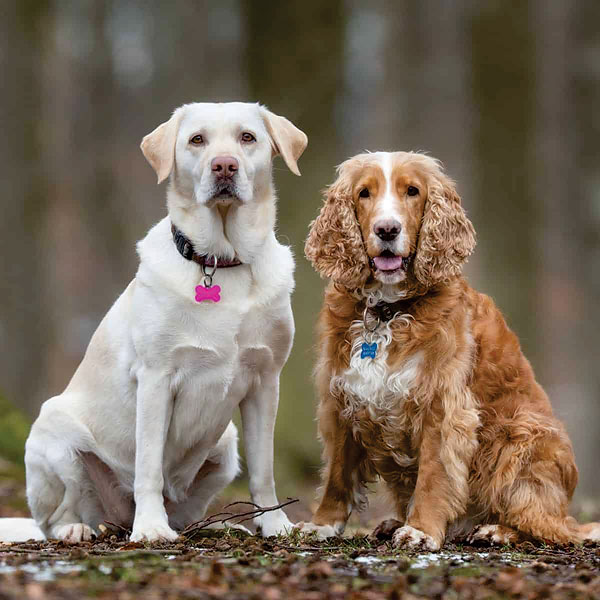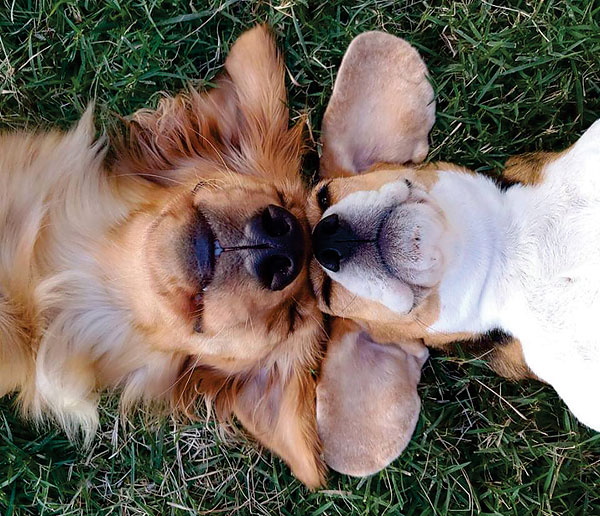If you love your dog as much as most pet owners do, the idea of adding another to the family may be enticing. Before you jump in, though, be sure to carefully weigh the pros and cons, and then make the introduction a positive one to start the relationship off right. With two dogs comes double the cuddles, kisses and companionship — but also double the veterinary bills, food costs and poop to clean up. If behavior issues develop, either due to the second dog or for another reason, it can also mean double the trouble. In many cases, however, having two dogs really can be better than having one.
Choosing the Right Second Dog
When choosing your second dog, be sure to take your first dog’s personality and temperament into account. Two well-matched dogs can become best of friends, providing each other with companionship and a built-in playmate. But dogs that aren’t well-matched can make each other — and you — miserable. Pat Miller, a certified dog behavior consultant, explained in The Bark:
“If your current dog is very assertive, adding another ‘top dog’ could be the equivalent of holding a lit match to an open gasoline can. Look for a dog who defers to your ‘Boss Dog.’ However, if your current dog is a Wilting Willie, an assertive new dog may take over. Willie will probably be fine with this, but you may have a hard time seeing him pushed around. If so, look for a non-assertive dog.”
Consider, too, the problems that could arise if you put two very anxious dogs together. Their anxiety may only feed off one another. In this case, a calmer dog may help to mellow out the other and even act as a source of calm for the anxious dog.
Age, energy level and size are other factors to consider. A very small dog can be easily injured by a larger dog, even during play, while a senior dog may not appreciate the energy that comes with adding a new puppy to the house. That being said, a younger dog may also help to bring out the playful side in your older pup, helping to increase activity. Sex is another factor; generally speaking, dogs of opposite sexes will get along best, and at least one must be sterilized.
Millions of dogs are waiting for their forever homes in U.S. animal shelters, foster programs and rescues, but the last thing you want to do is adopt a dog only to have to return him because he doesn’t get along with your dog at home. To avoid this, many organizations allow you to “try before you buy” to make sure you have a match made in heaven. Some may even require you to bring your first dog to the shelter to meet the potential new family member.
Set the Stage for a Positive Introduction
The first time the dogs meet, it should be in a neutral location, preferably outdoors where there’s plenty of room for the dogs to move freely. At first, however, both dogs should be leashed, with some slack so as not to increase tension. Some experts recommend not brining toys or food to the meeting, which could escalate an already stimulating experience into one that becomes out of control.
Miller, however, encourages bringing food treats as a tool to make the introduction more gradual and dissuade any potential tension:
“When the dogs notice each other, calmly feed hot dog bits, until each is focusing on the person providing the treats. Now slow the rate of hot dogs until the dogs glance at each other, then look back at you for hot dogs. If both dogs appear happy and/or reasonably relaxed in each other’s presence, drop the leashes while still at a distance and allow them to greet each other.”
Signs that the dogs are happy include wagging tales or playful antics. A bit of alertness or tension in the beginning is normal as well. But if either dog appears aggressive — such as lunging toward the other dog, snarling, snapping or barking excessively — seek professional help before proceeding further. If both dogs appear at ease, and you’re in a fenced yard, you can undo the leashes and allow the dogs to play. Once the dogs have exhausted their energy outdoors, you can bring them inside the house.
 Building a Happy Multidog Household Building a Happy Multidog Household
The introduction stage will continue beyond the initial meeting, so you should supervise the dogs closely in the beginning. Ideally, take a few days off of work to help with the transition and introduce your new dog to your daily routine. Be sure both dogs have their own space to retreat to, including separate crates, as well as ample choices for beds and toys and separate areas to eat in.
If you’ll be gone, separate the dogs into their own areas until you’re sure they can peacefully coexist. All dogs will have their own timetable when it comes to the adjustment period, but dogs coming from a shelter may require extra time to feel safe and secure. Senior dogs may also require additional time to adjust.
Using environmental adjustment aids, such as flower essences and dog appeasing pheromone (DAP) sprays and diffusers, can be beneficial. Be sure to continue to provide your first dog with plenty of love and affection, and stick with your regular routine as much as possible. Ideally, you’ll soon all feel like one big, happy family, second dog and all.
Dog-Friendly Walks/Hikes
in the Moab Area |
Corona Arch - Easy/Moderate. 1.3 Miles one way. Trailhead is 25 minute drive from Moab.
North on US-191 to Potash Road (Utah 279).
Mill Creek Pathway - Easy. 1.1 Miles. Little to no driving. Starts at the intersection of 100 South and 100 West,
a block off of Main Street.
Portal Overlook - Hard. 2.0 Miles one way. Trailhead is 20 minute drive from Moab.
North on US-191 to Potash Road (Utah 279).
Grandstaff Canyon - Moderate. 2.0 Miles one way. Trailhead is 10-minute drive from Moab.
North on US-191 to the River Road (Utah 128) |
|